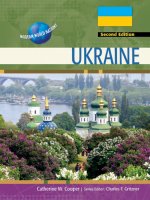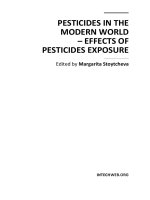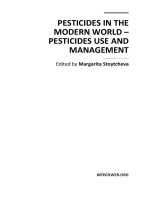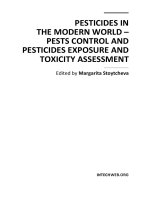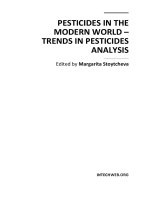- Trang chủ >>
- Khoa Học Tự Nhiên >>
- Vật lý
Modern world nations senegal
Bạn đang xem bản rút gọn của tài liệu. Xem và tải ngay bản đầy đủ của tài liệu tại đây (11.46 MB, 127 trang )
AFGHANISTAN
ARGENTINA
AUSTRALIA
AUSTRIA
BAHRAIN
BERMUDA
BOLIVIA
IRELAND
ISRAEL
ITALY
JAMAICA
JAPAN
KAZAKHSTAN
KENYA
BOSNIA AND HERZEGOVINA
KUWAIT
BRAZIL
MEXICO
CANADA
THE NETHERLANDS
CHILE
NEW ZEALAND
CHINA
NIGERIA
COSTA RICA
NORTH KOREA
CROATIA
NORWAY
CUBA
PAKISTAN
EGYPT
PERU
ENGLAND
THE PHILIPPINES
ETHIOPIA
RUSSIA
FRANCE
REPUBLIC OF GEORGIA
GERMANY
SAUDI ARABIA
SCOTLAND
SENEGAL
GHANA
SOUTH AFRICA
GUATEMALA
SOUTH KOREA
ICELAND
TAIWAN
INDIA
TURKEY
INDONESIA
IRAN
IRAQ
UKRAINE
UZBEKISTAN
Senegal
Janet H. Gritzner
South Dakota State University
Series Consulting Editor
Charles F. Gritzner
South Dakota State University
Philadelphia
Frontispiece: Flag of Senegal
Cover: Traditional hut used for grinding grain in a village in Senegal.
CHELSEA HOUSE PUBLISHERS
VP, NEW PRODUCT DEVELOPMENT Sally Cheney
DIRECTOR OF PRODUCTION Kim Shinners
CREATIVE MANAGER Takeshi Takahashi
MANUFACTURING MANAGER Diann Grasse
Staff for SENEGAL
EXECUTIVE EDITOR Lee Marcott
PRODUCTION EDITOR Noelle Nardone
SERIES DESIGNER Takeshi Takahashi
COVER DESIGNER Keith Trego
PHOTO RESEARCH 21st Century Publishing and Communications, Inc.
LAYOUT 21st Century Publishing and Communications, Inc.
©2005 by Chelsea House Publishers, a subsidiary of Haights Cross Communications.
All rights reserved. Printed and bound in the United States of America.
First Printing
1 3 5 7 9 8 6 4 2
Library of Congress Cataloging-in-Publication Data
Gritzner, Janet H.
Senegal /Janet H. Gritzner.
p. cm.—(Modern world nations)
Includes bibliographical references and index.
ISBN 0-7910-8023-4
1. Senegal—Juvenile literature. I. Title. II. Series.
DT549.22.G75 2004
966.3—dc22
2004014430
All links and web addresses were checked and verified to be correct at the time of publication.
Because of the dynamic nature of the web, some addresses and links may have changed
since publication and may no longer be valid.
Table of Contents
1 Introducing Senegal
8
2 Natural Environment
12
3 History
32
4 People and Culture
46
5 Administration and Government
62
6 Economy
74
7 Living in Senegal Today
90
8 Senegal Looks into the Future
Facts at a Glance
History at a Glance
Further Reading
Index
108
111
113
115
116
Senegal
1
Introducing
Senegal
S
enegal is a very special place. Few who have visited this West
African country forget its unique sounds, smells, sights, and
people. Although its people are of ancient lineage, today
they show the mark of outside influences. Their religion is Islam,
introduced from the Middle East, and their culture reveals the
imprint of 50 years of French colonial influence.
Senegal is the westernmost nation of West Africa. It lies farther
west than any European country except Iceland and lies only
1,800 miles (2,900 kilometers) from the Brazilian coast. It has a
total area of 75,749 square miles (196,190 square kilometers),
making it slightly smaller than the state of South Dakota. The
country is bounded by the Atlantic Ocean to the west, Mauritania to
the north, Mali to the east, and Guinea and Guinea-Bissau to the
south. The Senegal River defines the northern border between
8
Senegal lies further west than any European country except Iceland. It is also the
westernmost nation of West Africa and is bounded by the Atlantic Ocean to the
west, Mauritania to the north, Mali to the east, and Guinea and Guinea-Bissau
to the south.
9
10
Senegal
Senegal and Mauritania. The Faleme River, a tributary of the
Senegal River, delineates part of the eastern border with Mali.
The independent sliver-like nation of The Gambia forms a
virtual enclave of 4,361 square miles (11,295 square kilometers)
along the Gambia River in the southern part of Senegal. Except
where it meets the Atlantic Ocean, the Gambia is entirely
enveloped by Senegal’s southwestern region. Its 200-mile
(320-kilometer) east-to-west span physically and politically
separates the drier northern part of Senegal from the wetter
and more fertile region of the south.
Approximately one-fifth (19 percent) of the country is
considered suitable for agricultural uses, one-third (32 percent)
supports forest or savanna grassland cover, and the remaining
half (48 percent) is largely desert and noncultivable.
Dakar is Senegal’s capital, international gateway, and largest
urban center, with a population of nearly 2.5 million. The
sprawling city is located on Cap Vert (Cape Verde), a peninsula
that juts into the Atlantic and is swept all year by trade winds
from the sea. Its location on the continent’s most westward
reach places Dakar in a favorable position for trading with
Europe and the Americas. This advantage has helped the city
become the major trading center for all of West Africa.
Dakar is a city of great contrasts. It is home to shantytowns
and modern high-rises; streets are crowded with cattle and
Mercedes automobiles, and men and women whose lives have
been shaped as much by tribal custom as by twenty-first
century aspirations.
Senegal is a country of contrasting modern and traditional
life styles. Modernity, often with a French flavor, is found in
the cities and towns, especially those close to Dakar. Traditional
modes are found more often among people in smaller and
more remote towns and villages. In the country, many people
are simply too poor to enjoy modern lifestyles and amenities.
Remote villages may seem to have little in common with
urbanized Dakar, but most of Senegal truly is a mix of the
Introducing Senegal
modern and the old ways. Senegal is one of the world’s poorer
nations, yet although they are hard pressed economically, its
people possess a rich and varied cultural life.
The country’s Muslim character is imprinted on the landscape. One of the first things a visitor notices in Senegal is
the towering minarets of the mosques. “Call to Prayer” wakens
the country each day, as do roosters crowing and, even in a big
city like Dakar, the sounds of sheep and goats. Thus, religion
and ethnicity have shaped the character and personality of
Senegalese people.
Senegal has a history of kingdoms, empires, brotherhoods,
and colonial struggles (between and against colonizing powers).
but compared with much of Africa, Senegal is a relatively
modern state. The country has a tradition of moderation,
progressiveness, stability, and democracy. Its economic life is
tied to agriculture, fishing, and mining, but its fortunes are
often subject to the whims of weather and the market. Life is
hard for many, and, like many African countries, health concerns
are a major issue. Although beset with many problems, Senegal
has a bright future. Its economy is stable and on the upturn,
showing steady growth in the past few years.
Through this book, you will travel to Africa, visiting a
country where the humid tropics meet the desert. You will
study the country through time and learn about its people,
culture, government, and economy. You will see what it is like
to live in Senegal today and what the future may bring.
11
2
Natural
Environment
S
enegal is a land of many contrasting environmental conditions.
In this chapter, you will learn about its land and water features,
weather and climate, flora and fauna, and environmental issues.
GEOLOGIC STRUCTURE AND LANDFORMS
Senegal’s elevation extremes are the sea level shores of the
Atlantic and the Fouta Djallon foothills, which top out at about
1,900 feet (580 meters). The topography is relatively flat except for
low hills in the southeast. Senegal’s 330-mile (530-kilometer) coastal
plain is sandy from Saint-Louis to Dakar and swampy and muddy
south of Dakar.
Geologically, Senegal is composed of two primary relief features.
The first is a dissected, elevated region of folded and faulted rocks
in the southeast. These are rocks of the ancient “African Shield.”
They are primarily quartzite, granite, and granite-like schists (rock
12
The topography of Senegal is relatively flat except for low hills in the southeast.
Senegal’s 330-mile (530-kilometer) coastal plain is sandy from Saint-Louis to
Dakar and swampy and muddy south of Dakar.
13
14
Senegal
that has a foliated structure of thin layers and can be split
along approximately parallel planes). The second is a shallow
sedimentary subsidence basin composed of clayey sandstones of
varying thickness occupying the western and northeastern part
of the country. This is the “Continental Terminal” formation,
which occupies the largest part of the country. It consists of
a low plateau and plains overlain by windblown sediments,
alluvial (river-deposited) soil, and intermittent laterite
(hard clayey soil high in iron content) hardcap. The country’s
principal mineral resources are phosphates and iron ore.
SOILS
Senegal’s soils are dry and sandy in the north, iron-rich
(ferrous) in the central regions, and highly leached (with
nutrients removed) laterites in the South. In general, soil
fertility is low and the soil is extremely vulnerable to wind and
other forms of erosion.
Termite Mounds
One conspicuous feature of Senegal’s soil landscape is
the numerous termite mounds. Termites account for up to
one-half of the biomass of the African plains. The continent
is home to 400 species of termites, several of which are major
crop pests in Senegal. Where the mounds are especially large or
numerous, they can severely hinder farming operations.
Termite mounds are made of sun-baked mud. Inside the
mound are a series of tunnels that exit through chimneys,
which warm in the sun and draw cooler air and oxygen from
the bottom of the mound. Mounds vary in size, depending on
the termite species and on soil conditions. Some may be up
to 30 feet (9 meters) tall, with nests extending down to 50 feet
(15 meters) underground. In southeastern Senegal, mounds
up to 20 feet (6 meters) tall dot the landscape. These nests
can contain huge numbers of termites, with densities as high as
4 million termites per acre (9 million per hectare).
Natural Environment
Termites use their saliva to cement soil particles that form
the mounds, adding organic matter to the soil. In fact, there
are termite savannas in which trees and shrubs grow in tufts
in the enriched soil of termite nests. The value of termites is
disputed. The insects consume vast quantities of organic
matter, damage crops, and are blamed for increased soil erosion
that may occur around termite mounds. On the other hand,
termite colonies enhance soil fertility by transporting and
concentrating fertile subsoil clays near the surface and by
increasing soil aeration. African farmers often seek out termite
mounds and plant crops around them, because crop yields
usually are higher in these sites. Geologists have learned that
mound samples are useful in prospecting for various metal
ore deposits. Gold has been found in eastern Senegal by
people testing termite mounds!
Termites also are an important food for many animals and
birds and their mounds serve as lookouts for lions, cheetahs,
and leopards. Abandoned mounds may serve as home to
monitor lizards and other creatures.
WATER RESOURCES
Four major rivers flow westward through Senegal into
the Atlantic. From north to south they are the Senegal, Saloum,
Gambia (Gambie), and Casamance. These rivers are wide
and meandering, with broad estuaries (water passages where
the tide meets a river current) at their mouths. Lake Guiers
(Lac de Guiers), the country’s only natural lake, is located in
the north. It is the principal source of drinking water for the
Cap Vert region (Dakar and vicinity).
The Senegal is one of West Africa’s most important
rivers, with a length of 1,020 miles (1,641 kilometers) and a
drainage basin encompassing 174,000 square miles (450,000
square kilometers). Two of the river’s three headstreams rise
in the Fouta Djallon highlands in Guinea, after which the
river flows to the northwest and then to the west to drain into
15
16
Senegal
The Faidherbe Bridge crosses the Senegal River at Saint-Louis. The bridge
was named for the former governor of French Senegal, Commander
Louis Faidherbe.
the Atlantic. For 515 miles (829 kilometers) of its course, it
forms the boundary between Mauritania and Senegal. Two
dams have been built on the river: an antisalinity dam at
Diama completed in 1987 and a flow-controlled hydroelectric
dam at Manantali completed in 1988. The river has an
average annual flow of 23 billion cubic meters. Unfortunately,
only 4 or 5 billion cubic meters of flow are being used, leaving
a large amount of the country’s water supply lost as it flows
into the sea.
The Saloum complex of valleys and ponds provides water
seasonally, although it has a problem of seawater incursion far
upstream at low-flow stage. Except for its easternmost origins,
Natural Environment
The Saloum River is one of the four major rivers that flow westward
through Senegal into the Atlantic Ocean. All of these rivers are wide and
meandering as is shown by this view of the Saloum River.
the Gambia River is surrounded by the country of the Gambia.
The annual mean flow of the Gambia River is 10 billion cubic
meters. Only a small portion of the river is located in Senegal.
In the south, the Casamance River offers relatively low flows.
During most of the year, there are seawater incursions in its
middle and lower channels.
Most of Senegal’s water lies underground, trapped in an
aquifer (layer) of sediments. On a national scale, groundwater
resources are very abundant, except in the Tambacounda
region. The potential for exploiting this resource is highly
variable by region, however, depending on the capacity, depth,
and degree of mineralization of the aquifers.
17
18
Senegal
ECOLOGICAL REGIONS
Senegal can be divided into nine geographic or ecological
regions. They are the Senegal River Valley, the Long Coast, West
Central Agricultural Domain, Pastoral Domain, Casamance,
Eastern Plains, Eastern Transition Zone, Dakar Region, and
Shield Ecoregion.
The Senegal River
The Senegal River flows through Sahelian (desert fringe)
landscapes of Senegal, Mali, and Mauritania. Here, it creates a
unique and complex environment largely directed by what
happens on the floodplain. At one time, an extensive forest
dominated the river valley. Today, forest remnants are restricted
to shallow depressions and levees along the river. Many are
designated forest reserves.
Over the centuries, local peoples cleared most of floodplain,
known as the Walo, for traditional subsistence agriculture
and, more recently, for large irrigation projects. Some farmers
practice flood recessional agriculture on the heavy alluvial soils
(those with organic material deposited by water) found on the
banks of the river’s many channels. The Senegal River has been
the target for large development projects that have had mixed
results. Two planned dams were completed by 1987, but the
benefits from irrigation projects and hydroelectric power
have been slow in coming and negative ecological consequences
are now being felt. They include an increase in parasitic
diseases, a decline in food production (some of which is caused
by disruption of traditional flood recessional agriculture),
a decrease of dry-season pasture, and stress imposed on
remaining river woodlands.
The Long Coast
The Long Coast (Niayes Region) is a narrow coastal belt
containing small swamps, oases, creeks, channels, and mudflats.
This unique ecoregion is located along the country’s northern
Natural Environment
coast. It offers a variety of microenvironments formed by the
region’s humid maritime (sea) air and adequate moisture and a
land surface characterized by both active and stabilized coastal
and inland sand dunes. Between the dunes are depressions
called niayes, which harbor complex and rich flora, or plant
life. This region is famous for its market gardening: More than
two-thirds of the country’s vegetable production comes from
the niayes. The surrounding red-colored continental sand
dunes support a shrub savanna, used for centuries as grazing
lands by pastoralists (people who raise livestock).
West Central Agricultural Domain
This region includes the Groundnut (Peanut) Basin and
more recently colonized agricultural lands to the south and
east. The Groundnut Basin is Senegal’s commercial agricultural
center. It is an area of interior dunes with level or slightly
undulating topography. Two centuries of peanut cultivation
and a large rural population have contributed to the general
degradation of this basin’s sandy soils. Woodlands that once
covered the area have been replaced completely with a tree
parkland dominated by acacias. The central Sine and Saloum
area to the south forms a transition from intensive peanut
production to multicrop production of the southern Saloum.
It encompasses the traditional Serer agricultural lands and the
more recently colonized Wolof and Serer lands to the east.
Peanut cultivation has been expanding rapidly to the southeast since the 1950s. The region has higher rainfall and a longer
growing season than most of the Groundnut Basin, but it
lacks the heavy mantle of sand characteristic of the Groundnut
Basin’s best peanut-growing areas. The so-called new lands
(terres nueves) are possibly the fastest-changing environment
in Senegal. Natural land cover is being converted rapidly to
rain-fed agriculture. If the trend continues, agricultural crops
will replace the remaining natural vegetation in a few decades.
Woodlands are the primary source of fuel for home cooking
19
20
Senegal
and heating, and they are also important areas for livestock
grazing and foraging.
Pastoral Domain—The Ferlo and
Southern Sandy Pastoral Ecoregion
Ferlo is an inland continuation of the western plains and is
semidesert. It can be divided into two distinct subregions:
sandy Ferlo to the west and the ferruginous (iron-bearing)
Ferlo to the east. Sandy Ferlo is the heart of Senegal’s woodland
pastoral zone. It comprises a vast area of ancient dunes now
reduced to terrain of flat or gently rolling windblown sands.
The ferruginous zone, or ferruginous Ferlo, is distinguished
from the sandy Ferlo by its gravelly soils, which overlie exposed
laterites. The local relief (terrain) is more pronounced, dissected
by valleys that contribute to considerable variation in natural
vegetation. It is an area of generally poorer pastureland. As in
the sandy Ferlo, the presence or absence of water constitutes a
primary factor that determines the intensity of human and
animal pressure on the natural resources.
At one time, Ferlo was covered by a savanna landscape
marked by grasslands and a diverse tree species. Today, the
vegetation is much more open and lacks diversity. Many
observers have reported on the degradation of vegetation in
the Ferlo over the past 50 years. They point to a combination of
factors including low rainfall, pressure of a growing livestock
population (especially the concentration around wells called
boreholes), and the breakdown of the traditional pastoral
system among the Peul (local livestock raisers).
The sandy pastoral zone in the south is similar to the sandy
Ferlo of the north, except that it has significantly higher rainfall.
The area still is lightly populated, but it is feeling the effects of
aggressive agricultural expansion. This zone is part of Senegal’s
extensive pastoral region and has more reliable and productive
grasslands than do regions to the north and east. It contains
large pastoral and forest reserves set aside by the colonial
Natural Environment
government in the 1930s. Northern pastoralists use these
grazing lands regularly for dry-season grazing. Today, the
predominant vegetation cover is shrub and tree savanna.
The Casamance
The Casamance is known for its lush forest landscapes,
valley bordered by palms, and wet rice fields. Casamance is the
region located south of the Gambia River and is distinguished
from other regions by high seasonal rainfall, a well-developed
drainage system, iron-rich (ferralitic) soils, and relatively
dense and diverse vegetation. It is home to a number of ethnic
groups and is separated physically from the rest of Senegal by
the Gambia. Today, Casamance is showing signs of the same
type of degradation taking place elsewhere in the country.
Pressures are coming mainly from expanding agriculture and
charcoal production.
Eastern Transition Ecoregion
This region is similar to the area of agricultural expansion,
except that it is farther from the heavily populated Groundnut
Basin and lateritic plateaus are common. The region is an
important source for fuel wood, mainly in the form of
charcoal. Typically, charcoal producers come through an area
and reduce woody cover by half. The region’s eastern margin
remains largely unaffected, but, with the growing appetite for
fuel wood, it is an area at risk.
Dakar Region
The Dakar Region is the country’s smallest ecoregion.
Here, more than anywhere else in the country, the human
imprint dominates the landscape. Cap Vert was formed in part
by ancient volcanic activity, and exposure to southwesterly
winds is responsible for the peninsula’s greenness—a sharp
contrast to the yellow dunes to the north. The land cover type
is a mix of woody species, shrubs, and herbaceous (leafy)
21
22
Senegal
species. Gnarled baobab trees in small or large groupings are
found within the Dakar Region.
Shield Ecoregion
This lightly populated region in the southeast part of the
country is far from Senegal’s population centers and has
limited agricultural potential. A large part of this area falls
within the Niokolo-Koba National Park, which contains some
of the most unspoiled arid and semiarid types of flora and
fauna left in Africa.
Geology is what sets this region apart. Exposed ancient rock
formations yield Senegal’s only mineral resources. Numerous
metallic and nonmetallic minerals, including gold, iron, marble,
diamonds, copper, uranium, and manganese, have been found.
Several new mining towns have appeared, and newly paved
roads are opening the region for development.
WEATHER AND CLIMATE
Across Senegal, rainfall is widely dispersed in both location
and timing. The country lies on the equatorial side of 17 degrees
north latitude, placing it well within the tropics. Temperatures
are high throughout the year, and the country experiences
pronounced wet and dry seasons. The coastal area is remarkably cool considering the latitude.
Dakar ranks as one the coolest, breeziest spots in West
Africa. Average temperature ranges in Dakar are from 64 to 79°F
(18 to 26°C) in January to 75 to 90°F (24 to 32°C) in September.
Interior temperatures are higher than along the coast, but the
humidity is lower.
Rainfall patterns in West Africa are more unpredictable
than in other parts of the continent. Senegal’s rainfall can be
variable, and the country has experienced long dry periods.
During the 1970s and 1980s, rainfall declined significantly;
it has, however, increased in recent years. The quantity for a
certain year may be normal, but the rainy season may vary
Natural Environment
greatly in beginning, length, and end, especially in central and
northern Senegal.
Annual rainfall is almost entirely limited to the summer
wet season, which lasts up to six months (May to November)
in the south and decreases to three months (July to September)
in the north. Amounts of rainfall also increase from south
to north. Average rainfall varies from more than 60 inches
(1,500 millimeters) in the southwest to just under 12 inches
(300 millimeters) in the northwest. Dakar gets more than
24 inches (600 millimeters) annually, most of which falls
in June and October.
Senegal lies in the zone of the northeast tradewinds, and a
wind called the harmattan affects the country most. This wind
can blast West Africa’s Sahel region for days at a time. During
the dry season, it blows as a hot dust-laden blast of air from
the Sahara Desert. Gale force squalls and even occasional
tornadoes can occur at the beginning and end of the rainy
season. If a harmattan is unusually persistent, its parched winds
will dry out both crops and water sources.
VEGETATION
Senegal is the most biologically diverse country in the
Sahel—the southern edge of the Sahara Desert that stretches
across most of Africa. Although Senegal is a small country, it is
part of three bioclimatic zones: the Sahelian, the Sudanian, and
the Guinean zones. Vegetation change, caused by the extreme
annual rainfall differences between the semiarid north and the
wetter south, is pronounced. Although mostly covered with
savanna, the country becomes semidesert in the Sahel region
of the north and northeast and forested in the southwest.
The driest zone is the Sahelian Region in northern Senegal.
Here, an average of 12 to 20 inches (300 to 500 millimeters) of
precipitation fall annually. Early seasonal rains, which usually
begin in July, transform the landscapes for a short period of
time into lush green grazing land, which is its primary use.
23
24
Senegal
The driest zone of the arid Sahel region lies in northern Senegal. Long
distances are often traveled to reach the wells, which are few in number.
Animals must be given enough water to last to the next water source.
By late September, however, rain ceases and grasses quickly dry
out. Shrub savannas, shrub and tree savannas, and bushlands
dominate this land. The woody cover, mostly umbrella-shaped
acacia trees, rarely exceeds 25 feet (8 meters) in height.
The Sudanian Region lies to the south of the Sahelian zone
and covers about two-thirds of central and southern Senegal.
Typical vegetation types include the savanna woodland and the
dry woodland. Most areas in this region receive 30 to 60 inches
(750 to 1,500 millimeters) of precipitation annually. Here,
rain is spread over five to six months, mostly in July through
